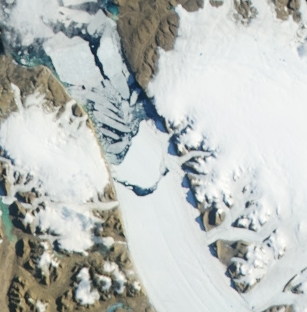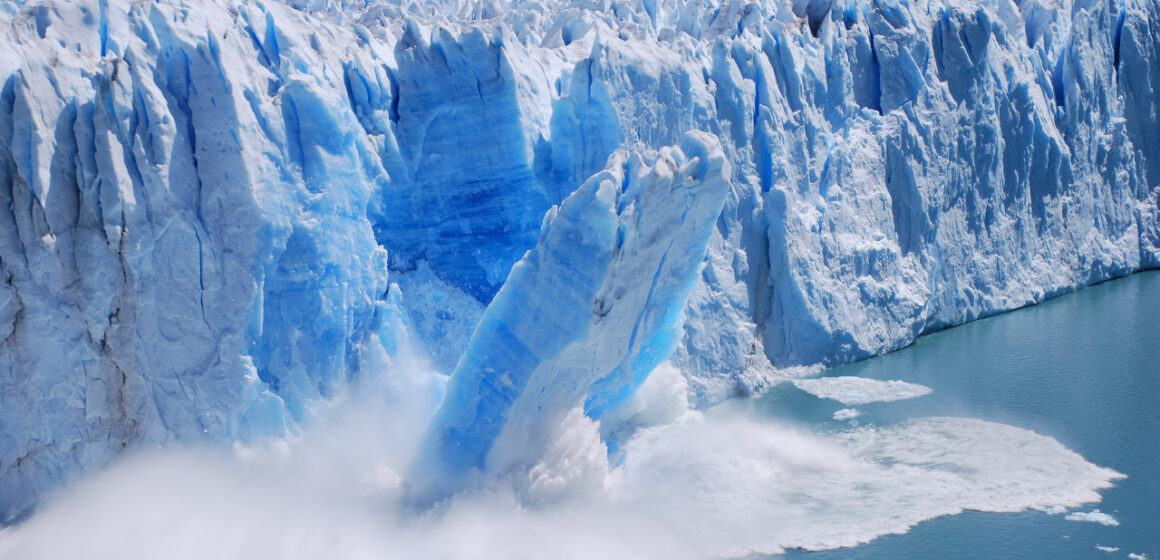When it comes to climate change, skeptics often argue that we have an incomplete understanding of Earth’s systems. While humanity has yet to unlock all of the world’s secrets, that doesn’t mean we can’t act on what we know. In many cases, as climate scientists dig deeper, they find even more supporting evidence for potential upheavals ahead.
In the harsh landscapes of Greenland, a team of intrepid researchers from UC Irvine and NASA’s Jet Propulsion Laboratory discovered a hidden aspect of ice-ocean interaction. Their discovery could potentially upend our understanding of sea level rise.
The tide is high
 Scientists have been studying the Petermann Glacier for some time. This photo was taken in 2013 about a year after a large iceberg broke off, pushing the front of the glacier significantly upstream. credit: NASA, public domain
Scientists have been studying the Petermann Glacier for some time. This photo was taken in 2013 about a year after a large iceberg broke off, pushing the front of the glacier significantly upstream. credit: NASA, public domainAs we grapple with the accelerating impacts of climate change, one of the biggest looming threats is sea-level rise. Melting sea ice is not a threat because it does not cause sea level rise. Instead, the real problem is land ice, with the vast ice sheets of Greenland and Antarctica acting as colossal water reservoirs.
As our planet warms, these ice sheets melt into the ocean, causing sea levels to rise. This naturally comes with consequences for people. The greatest threat is to coastal communities, where increased flooding or total inundation could render some areas uninhabitable. There is also the threat that sea level rise could render some agricultural land unusable due to increased salinity, affecting even those living inland due to food shortages.
Projecting the rate of sea-level rise is a complex puzzle with many interrelated mechanisms. Researchers must take into account factors such as air temperature, ocean currents and the physical characteristics of the ice sheets themselves. But as this new research reveals, there may be more to the story.
 In 2012, a large iceberg was seen breaking off from the Petermann Glacier. Glaciers lose mass by melting, sublimation, and as an iceberg is released into the sea. credit: NASA, public domain
In 2012, a large iceberg was seen breaking off from the Petermann Glacier. Glaciers lose mass by melting, sublimation, and as an iceberg is released into the sea. credit: NASA, public domainThe scientists focused their research on the Peterman Glacier in northwest Greenland. Using satellite radar data, they found that the glacier’s “grounding line”—the point where the glacier detaches from bedrock and begins to drift into the ocean—moves significantly with tidal cycles. This movement, significantly greater than expected, allows warm seawater to penetrate far below the glacier, accelerating the melting of the ice. The data collected by the researchers suggests that the grounding line is more of a “grounding zone” that migrates 2 to 6 kilometers as the tide moves in and out.
Essentially, the researchers found that warm seawater carved channels under the ice, particularly in the “grounding zone,” leading to increased melting rates. The team observed a dramatic example of this between 2016 and 2022, when the glacier’s ground line retreated by 4 kilometers. In the process, a 670-foot-high cavity formed beneath the glacier, carved out by retreating warm water.
This finding contradicts the traditional understanding that these grounding lines remain static during tidal cycles and are immune to melting. The implications of these findings could be significant. The team suggests that if these neglected ice-ocean dynamics were accounted for in models, estimates of future sea-level rise could double. This is not limited to the Petermann Glacier – the same can apply to any glacier that terminates in the ocean. This includes glaciers in most of northern Greenland as well as Antarctica in its entirety.
 Warmer water tends to get under the glaciers and melt them from below. Now researchers have found that the grounding line where the melting occurs can actually move significantly with the tides, which would dramatically accelerate sea level rise.
Warmer water tends to get under the glaciers and melt them from below. Now researchers have found that the grounding line where the melting occurs can actually move significantly with the tides, which would dramatically accelerate sea level rise.This suggests that the already serious problem of sea-level rise may be even more pressing than we thought. We already know that the Greenland ice sheet has lost billions of tons of ice in recent decades, largely due to warming subsurface ocean waters. The interaction between this warm water and the ice accelerates the movement of the glacier seaward, leading to faster ice loss.
As our understanding of the complexities of climate change continues to grow, the Greenland study is a sobering reminder that some variables may remain hidden under the ice, so to speak. This is a classic case of science in action: our models and predictions are only as good as our understanding of the systems involved. As we continue to explore the depths of climate change, let this remind us that there is always more to learn and that the quest for knowledge never ends, especially when the stakes are so high.
It will be a wonderful moment to find out that some hitherto unknown mechanism means that we will all be safe from the expected dangers of climate change. Unfortunately, however, most new research seems to confirm that bad times are ahead, much of which says the danger is on a more advanced timetable than previously thought.


Leave a Reply